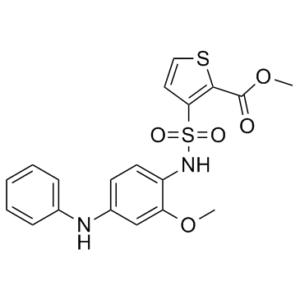GSK0660 is a potent and selective antagonist of PPARβ and PPARδ with IC50 values of both 155 nM, it has little or no activity on PPARα and PPARγ with IC50 values of >10 μM. GSK0660 at 100 nM decreases the expression of the PPARβ/δ target gene CPT1a below the basal vehicle-treated level by about 50%, but has no effect on the expression of the PPARβ/δ target gene PDK4, which is also present in skeletal muscle cells. Additionally, GSK0660 prevents the upregulation of CCL8, a chemokine involved in leukocyte recruitment, caused by TNFα.
Physicochemical Properties
| Molecular Formula | C19H18N2O5S2 | |
| Molecular Weight | 418.49 | |
| Exact Mass | 418.065 | |
| Elemental Analysis | C, 54.53; H, 4.34; N, 6.69; O, 19.12; S, 15.32 | |
| CAS # | 1014691-61-2 | |
| Related CAS # |
|
|
| PubChem CID | 46233311 | |
| Appearance | Light yellow to yellow solid powder | |
| Density | 1.4±0.1 g/cm3 | |
| Boiling Point | 608.1±65.0 °C at 760 mmHg | |
| Flash Point | 321.5±34.3 °C | |
| Vapour Pressure | 0.0±1.7 mmHg at 25°C | |
| Index of Refraction | 1.650 | |
| LogP | 2.75 | |
| Hydrogen Bond Donor Count | 2 | |
| Hydrogen Bond Acceptor Count | 8 | |
| Rotatable Bond Count | 8 | |
| Heavy Atom Count | 28 | |
| Complexity | 618 | |
| Defined Atom Stereocenter Count | 0 | |
| SMILES | S(C1C([H])=C([H])SC=1C(=O)OC([H])([H])[H])(N([H])C1C([H])=C([H])C(=C([H])C=1OC([H])([H])[H])N([H])C1C([H])=C([H])C([H])=C([H])C=1[H])(=O)=O |
|
| InChi Key | NDFKBGWLUHKMFY-UHFFFAOYSA-N | |
| InChi Code | InChI=1S/C19H18N2O5S2/c1-25-16-12-14(20-13-6-4-3-5-7-13)8-9-15(16)21-28(23,24)17-10-11-27-18(17)19(22)26-2/h3-12,20-21H,1-2H3 | |
| Chemical Name | methyl 3-[(4-anilino-2-methoxyphenyl)sulfamoyl]thiophene-2-carboxylate | |
| Synonyms |
|
|
| HS Tariff Code | 2934.99.9001 | |
| Storage |
Powder-20°C 3 years 4°C 2 years In solvent -80°C 6 months -20°C 1 month |
|
| Shipping Condition | Room temperature (This product is stable at ambient temperature for a few days during ordinary shipping and time spent in Customs) |
Biological Activity
| Targets | PPARβ/δ (IC50 = 22.9 μM) |
| ln Vitro | GSK0660 suppresses the proliferation and differentiation of human retinal microvascular endothelial cells (HRMECs)[2]. |
| ln Vivo | GSK0660 is quickly eliminated from the blood and does not build up in vivo[1]. GSK0660 works well against retinal NV when injected intravitreal or intraperitoneally. The benefits of intravitreal injection include the ability to deliver high doses of medication to the active sites of neovascular disease; however, this mode of administration is also linked to harmful side effects, such as glaucoma, cataractogenesis, and endophthalmitis. The use of systemic administration, which prevents these side effects, is limited by the requirement for repeated dosages in order to achieve the desired levels of active drug in diseased tissues. Additionally, it exposes healthy tissues and organs to active medication needlessly[2]. |
| Enzyme Assay | GSK0660 is almost inactive against PPARα and PPARγ, with IC50s of both >10 μM, and a strong antagonist of PPARβ and PPARδ, with IC50s of both 155 nM. With a pIC50 of 6.8, GSK0660 completely inhibits PPARβ/δ activity. While PDK4 expression, another PPARβ/δ target gene in skeletal muscle cells, is unaffected by GSK0660 (100 nM), it decreases CPT1a (a PPARβ/δ target gene) expression below the basal vehicle-treated level by about 50%. |
| Cell Assay | HRMECs were cultured under standard tissue culture conditions after being seeded at a density of 2 × 105 cells/well in six-well plates. Following a 12-hour serum starvation period at 80% confluency, the cells were treated for six hours with either a 0.5% serum-containing vehicle (0.1% DMSO) or PPAR-β/δ agonist GW0742 (0.01, 0.1, or 1.0 μM), or a 2% serum-containing vehicle or PPAR-β/δ antagonist GSK0660 (0.01, 0.1, or 1.0 μM). After twice washing the cells in cold PBS, total RNA was extracted. Transcribing the total RNA extracted from the culture wells was done in reverse. There was quantitative RT-PCR. |
| Animal Protocol |
Sprague-Dawley rat 0.2 or 1.0 mg/kg i.p. |
| References |
[1]. Mol Endocrinol . 2008 Feb;22(2):523-9. [2]. Invest Ophthalmol Vis Sci. 2013 Jun; 54(6): 4197–4207. Published online 2013 Jun 19. |
| Additional Infomation | 3-[(4-anilino-2-methoxyphenyl)sulfamoyl]-2-thiophenecarboxylic acid methyl ester is a sulfonamide. |
Solubility Data
| Solubility (In Vitro) |
|
|||
| Solubility (In Vivo) |
Solubility in Formulation 1: ≥ 2.5 mg/mL (5.97 mM) (saturation unknown) in 10% DMSO + 40% PEG300 +5% Tween-80 + 45% Saline (add these co-solvents sequentially from left to right, and one by one), clear solution. For example, if 1 mL of working solution is to be prepared, you can add 100 μL of 25.0 mg/mL clear DMSO stock solution to 400 μL PEG300 and mix evenly; then add 50 μL Tween-80 + to the above solution and mix evenly; then add 450 μL normal saline to adjust the volume to 1 mL. Preparation of saline: Dissolve 0.9 g of sodium chloride in 100 mL ddH₂ O to obtain a clear solution. (Please use freshly prepared in vivo formulations for optimal results.) |
| Preparing Stock Solutions | 1 mg | 5 mg | 10 mg | |
| 1 mM | 2.3895 mL | 11.9477 mL | 23.8954 mL | |
| 5 mM | 0.4779 mL | 2.3895 mL | 4.7791 mL | |
| 10 mM | 0.2390 mL | 1.1948 mL | 2.3895 mL |
